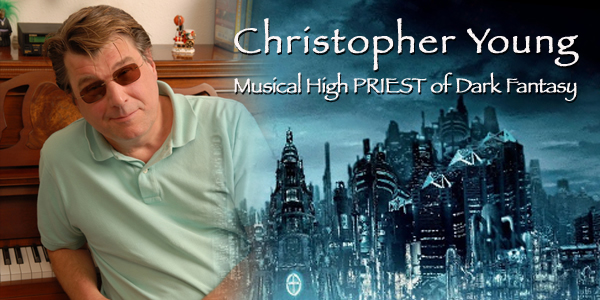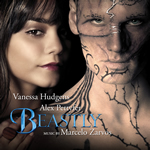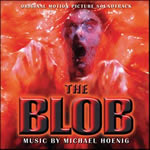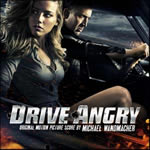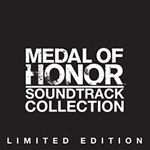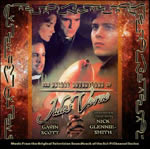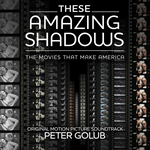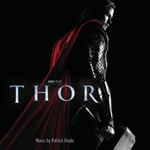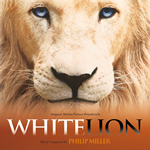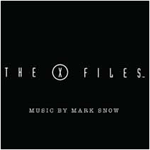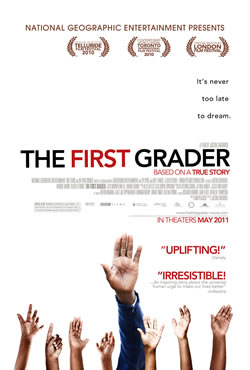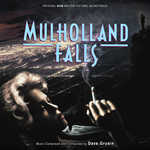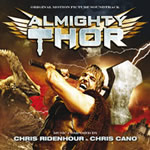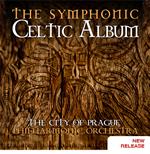
 |
Soundtrax: Episode 2011-5
May 15, 2011By Randall D. Larson
Photo: Rudy Koppl Scott Charles Stewart’s film PRIEST has some horrific elements, but it’s not an outright horror film but more of a sci-fi/fantasy thriller. “It is about a planet that lives in darkness most of the time and our hero is a priest who turns his back against the church,” composer Christopher Young explained. “The priests no longer have a real function in this society – at one time they were the chosen ones who rid the planet of the presence of vampires, or so it was believed, now the whole surviving community is about honoring the will of God, the will of God is taught by the church, because without it there is no unity and no direction. So his brother is killed and his niece is captured by the vampires. The church forbids him to go out and try to hunt down vampires, who they believe they’ve gotten rid of, so he turns his back on the church, and the church is after him.” Stepping up to the podium to define and flavor this epic conflict, Young once again engages the dark fantasy genre and constructs a score that is compelling, energizing, and melodically invested with more than a dozen integrated themes and motives. I interviewed Young the day before the film opened and discussed in detail his experiences on this film.
Q: What can you tell me about PRIEST? I don’t believe you’ve worked with the director, Scott Charles Stewart, before?
Christopher Young: This was the first time. I was mighty lucky that he sought me out. He had been a fan of my scores before hand – I think mostly my Gothic horror and sci-fi scores – but I think the thing that attracted him to me was I could do that while at the same time coming up with some tunes, and he felt that was something important for the score accomplish. It wasn’t enough to write good dramatic music, it had to be dramatic music that whenever possible was held together by themes.
Q: Like his previous film, LEGION, this movie has this whole religious/morality/good-versus-evil type of thing, which is right up your dark alley. How did you approach the score in that regard, or what did Scott ask of you?
Christopher Young: I’ve got to make a confession to you: I’ve never seen LEGION or heard its score! John Frizzell, as Scott said to me, was a studio favor that was pushed on him for LEGION. I’m sure John Frizzell had done a remarkable score, but for PRIEST Scott wanted to be able to make up his own mind and be in the driver’s seat. I feel bad for John, but I think Scott was looking for something else here.
Q: When you first got involved in PRIEST where did you draw your initial thoughts as to this is what the score should be about?
Christopher Young: This is not such an easy question to answer, because the other reason was that I was brought on board was that I had worked for Screen Gems before. The man who runs Screen Gems, Clint Culpepper, is a very hands-on post –production guy, and he had extremely strong opinions about the music. As Scott said to me, “one of the other reasons I like having you on this movie is you’ve worked for Clint before and you know how to navigate around him, because he’s got such strong opinions.” So in a roundabout way I would guess my consideration, first and foremost, was how to make Clint and Scott both happy – how do I understand how they see the film? But fortunately we all fell in line. The score is Gothic/religious – dark with a helluva lot of bombastic action. That’s what they were looking for, a relentless drive in the score, to constantly push the film forward and to assist the film in having a bigger scope.
Q: The score has kind of a weight to it, as if you’ve got the whole presence of heaven and the cosmos bearing down on this character and what’s going on.
Christopher Young: That’s it, precisely. It’s both heaven and hell and the potential of hell winning out and overcoming the world and pushing heaven out permanently. There’s a distinct battle between the church and the vampires, so it’s that sturm-un-drang battle between two titans that was always governing my thought process. Any time I did start to thin things out I questioned if this the right time to do this, is it getting too transparent?
Q: It’s hard in a film having to do with religious elements not to use a choir but at the same time your use of choir is so well integrated into the dynamic of the orchestral music that it doesn’t seem clichéd.
Christopher Young: It doesn’t really stand out. I was asked this question by someone else who interviewed me today, and I said, “I don’t think I thought of the choir in quite as distinctive a way as I have in some other movies that I’ve used choir in,” and she said “what do you mean by that?” I said there was a film I did called SPECIES, and in that I made a conscious decision, because it was about a female alien, to exclude men from the choir. It’s a subtle thing and you might not notice it. In PRIEST my approach is more of an element of a larger instrumental idea.
Q: Having come from a huge background, as we know, within horror, how did you adapt your style into this score and create something fresh?
Christopher Young: You know what’s interesting about this? I’ve just been revisiting THE CORE, which is going to be coming out officially and I’ve just spent the last couple days listening to that and making some changes. There are fewer dissonances in PRIEST, certainly less dissonances than in THE CORE, but the dissonances in the chords in PRIEST are not created by clusters, as they usually are. Clusters are the mainstay of horror music, as you know – groups of notes that have no pitch center. Now I did use some of that in PRIEST but I tried to stay away from it. That’s the main thing that differentiates this being a science fiction/fantasy film that has horror elements to it rather than a straight out horror film like EMILY ROSE or THE GRUDGE. THE GRUDGE is a classic example of a score that is basically about figuring out creative ways to use this cluster concept, which is the basic content of 90% of the score, and how to do so in such a way that makes musical sense. That was what was governing me in PRIEST.
I went through PRIEST for my USC class and I discovered there were actually thirteen different musical ideas in that score. Of those thirteen, eight themes have eight or more bars; we have two motive themes for the vampires and the vampire train (they don’t have a theme they just have a motive); and then finally we have sound bytes that appear. I would never have recommended this even to my own students when working on a feature – don’t weigh the film down with so many different ideas, try to hold it together with as few as possible, like, for example, LAURA, which is held together basically by one theme. Here we have a multitude of different ideas, although you can hardly hear them, they’re so buried. There are subtle things but there are ideas that reappear. There’s The Priest theme, which is the most important theme, there’s the Family Theme, which is the second most important theme, both of which you hear in their full form in the end credits – the End Credits start off with the ostinato, and then comes the Priest Theme, which modulates and we go to the Family Theme. Interestingly, what differentiates the Main Title from any other Main Title I think I’ve done is that the ostinato is pretty much the same as the end credits, but the theme itself that introduces the movie is one that I never really use again. I use it for the prolog - the film starts out with a prolog in which they talk about the history of mankind and the vampires, and they use animation to communicate the story, and that exact theme I never use again in the movie. It’s the seed of what you’re going to hear later as the official Priest Theme.
I should add something else – that score that you hear on the digital album was written for a version of the movie which no longer exists. It’s the first time that I’ve ever been asked to write a score and have it recorded, mixed and dubbed into a version of the movie for test purposes. In other words, before he was willing to test the movie, Clint Culpepper wanted to have the completed score in. So they went out and tested the film and it did not do very well. Thank the Lord I was not the victim of that – with most composers they would have blamed the score on the bad test and dumped it out. But they loved the score so they ended up pulling in Bob Murawski, the editor I worked with on SPIDER-MAN 3 and DRAG ME TO HELL and who’d also won an Academy Award for HURT LOCKER, and they completely re-edited and re-structured the film. They added the prolog, and every single music cue has been edited. This is the first time where every single cue I’d written has been edited. I had to write some more music that had to replace things that either they weren’t happy with based on the new cut or that they couldn’t edit. The Main Title, which is on the album, had to be edited.
Q: Did you have to deal with a temp score on this project?
Christopher Young: The temp score was a lot of DARK KNIGHT and TRANSFORMERS.
Q: I was going to ask you about that, because there seem to be some elements in the PRIEST score that you haven’t necessarily used before, such as the marcato strings and some of those of rhythms that have been largely associated with those kinds of films, and yet they seem to have been used very effectively in PRIEST, and you have made them your own.
Christopher Young: Now that you tell me that – I’d completely forgotten that these scores had that this marcato thing! I honestly can’t remember that they had them. I must have listened to them and thought that’s probably an element Scott wanted, that rhythmic element that those scores had. I thought, ok, I cannot turn my back on that. If he thinks that is the personality of what the score should be, I’m shooting myself in the foot if I don’t acknowledge it. Quite frankly, I can’t remember him specifically insisting on that figure, but I guess I assimilated it into myself.
Q: That’s become technique heard in a lot of action scores nowadays, but it gives PRIEST a tremendous drive and movement. It’s almost like you’ve got this wave that is just propelling itself along and pushing the film’s action along with it.
Christopher Young: Well, that’s good! And it’s not like I’m using it all the time! It’s only there for the main title, the end title, and some of these cues.
Q: What was most challenging for you about scoring PRIEST?
Christopher Young: The most challenging thing without a shadow of a doubt was writing the last two reels of music. Reels five and six – the extended action climax – are essentially non-stop music. That was a 15-minute frigging action cue I had to write for this big finale where the vampire train is heading toward the Cathedral City and there’s all this fighting going on. The only time I’ve ever had Clint Culpepper get upset with me was over this sequence. Black Hat, the head vampire, is hypnotizing the young heroine in the movie on the top of a train, and the director and I agreed that we could stop the forward motion in the music and we can just relax a bit because he’s hypnotizing her, but Clint was adamant that the music had to be constantly moving forward. I said, “15 minutes of it?” He said “Yes!” In my mock-up, my first score for this, I stopped the action for about twenty seconds, and he had a conniption fit! So how do you get fifteen minutes of constant action?! That was the challenge. Ultimately everyone thought it was working really well. On the album, I cut it up into different portions.
Q: I like the sequencing on the album. It takes a journey and, not having been able to correlate it to specific film scenes yet, you’re led on a very interesting musical journey from the opening cue to the massive finale. There’s a very decisive thrust to it on the album.
Christopher Young: I think there are a lot of composers who are not as involved as I am in structuring a soundtrack album in such a way that it makes a performance. You walk on the stage with a shebang and you’ve got to make your introduction with a splash. Then you do your little shtick, your entertainment, and then you get off the stage with another splash before the hook takes you off. It’s a performance.
Q: What is often forgotten by some collectors is that the music on a soundtrack album is a different entity than it is in the film. Sometimes the music works differently on the album than it does in the film, and you want to make sure the album provides the most effective listening experience in that medium, which may not always mirror the order in which the cues appear in the movie.
Christopher Young: Exactly. Back in the old days, one thing I loved about records is that you had to limit your performance. For instance, PLANET OF THE APES is always cited as one of Jerry’s best, and yet the record has like 12 minutes on a side or something?! I’ve never heard anyone complain that the record’s too short – if you wanted to hear more, you just want back and played Side 1 all over again! With CDs now it’s more or less expected that you fill up as much of the 82 minutes as possible, and I am never sure if I have overextended my welcome or not. So I do try and structure things much the same way that Goldsmith would in his classic albums with theme and variations. You lay out your most important themes in the first two or three tracks, and then bring in the variations on them. And I always like to have a big action cue before the end credits. Back when we did vinyl, of course, we had to have the side-turner cue, something which is going to inspire the listener to flip the record, and then you had to have a good opening title for the second side, and then there were usually a couple of tracks that might be considered a little dead weight and then you come to the rousing climax and then into the end credits. Of course now with Pro-Tools it’s a lot easier to segue and to edit, so a lot of these tracks, if you saw the list of what they’re comprised of, are actually compiled from several cues.
Q: When you’re working on a complex score for a film like PRIEST, you’ve got your assistants helping out in various capacities to get it all done. How does this work?
Christopher Young: My system here is very weird, it’s probably one of the weirdest ones in the world! I’m old school, trying to assimilate myself into new school thinking. John Williams is pure old school. He sits at the piano, he makes sketches, the sketches go to the orchestrator, if the director wants to hear what he’s been writing, he listens to him play the score on the piano. He does not do mockups.
Q: He may be the only Hollywood composer who can get away with that!
Christopher Young: There are a couple other ones who work like that. Rachel Portman over in England does not usually do mockups. She tries to discourage it but she will have some done if it’s insisted. She’s in the old school too. Now, I was a late bloomer in terms of assimilating the concept of synths into my world, for mock-up purposes. Not for musical purposes, for the scores themselves, but for mocking things up. But I’m not a tech wiz when it comes to computers and synths. I used to be! When I was at UCLA, I had a command over the old Moogs and the ARP synthesizers and the whole patch bay concept, I had completely mastered that. But on the first films I got, before they had synths, were those Corman things where they wanted me to do orchestra stuff, so I got away from technology and my brain just doesn’t want to wrap around it nowadays. So what does this mean? It means that I don’t write into the computer. I’ve never done that and probably never will as long as I can afford it. I’ll sit at an upright piano and then I’ll determine exactly what I want the cue to be. I’ll determine every single line, and then I have a MIDI-to-piano, because I have also gotten to the point now where I don’t pick up a pencil that often.
Why is that? At one point I was working on two movies at the same time, not at my own choosing – it was URBAN LEGEND and ROUNDERS. I had to re-do a lot of the ROUNDERS music and I was having to pump out music for URBAN LEGEND. Someone on my team at the time said, “Chris, what is it that takes the most time in completing a cue – is it the conception or is it the getting the notes on the paper?” I said “getting the notes on the paper takes about twice the amount of time as conceiving the cue.” He said, “well, you’ve got to write six minutes of music a day for the next two and a half weeks to get to the finish line. You can do one of two things: have people ghostwrite it or maybe just not worry about putting the notes on the paper and just conceive of the six minutes every day.” I said “how are we going to do that?” He said “Let me put together a team of people who actually do the take-downs of the notes. You tell them exactly what the notes are and they’ll do the take downs.” So that’s what happens. I have a team of assistants, and one of the things that’s really important in terms of their jobs is getting the music sketches prepared. I used to insist everyone use pencil and paper, but now they are converted to computer. They prepare the sketches by coming into my composing room with their cassette machine and a digitized piano, and they walk out with enough information to know exactly what each part is supposed to be doing. They create the sketch, they show me the sketch, I tell them what corrections may be needed, they then take the sketch downstairs and turn it over to my synth guys who proceed to input the notes from the sketch and create the mock-ups. I then go downstairs when I’m told the cue is ready for me to hear, and make my comments on it, and they keep adjusting the cue until I’m happy with it. My team is larger than most because of that, but it allows me the advantage of not writing it to synth. It is much more costly but I think it’s benefitted my music tremendously. If I was a synth dude and I only write it for synth, I don’t think the score for PRIEST would sound the same. Everyone who writes at the synth, sooner or later their mind starts wrapping around what it is the synth does well and what it doesn’t do well, and they start modifying their orchestral thinking to accommodate these issues. I can generally tell when somebody has done an orchestra score that was written at a synth and then was translated to an orchestra by the orchestrators.
Q: There’s an inherent restriction to the size and dynamic of the music that you will find there.
Christopher Young: It’s the dynamic and it’s also harmony. The one thing that synths do well, going way back to Giorgio Moroder and Tangerine Dream, is drones – this pulsing of single tones – and that kind of neutralizes harmony. Bye-bye Erich Wolfgang Korngold and harmony, you’re stuck on a drone now! Now Hans Zimmer has made an art out of it but there’s a lot of guys who write pretty much exclusively for the orchestra whose music still hangs around the drone. I’m not saying it’s bad, I’m just saying I think what the synth does well has influenced their way of writing for the orchestra. I think PRIEST is more harmonically complex than a score that hangs around a drone, and I think that’s my selling card as a composer.
Q: PRIEST is a broadly orchestrated score, because there’s depth to it. You’ve got your melodic lines but the harmonic and textural depth just goes for miles, and I think that’s what makes a lot of your stuff stand out.
Photo: Xavier Ducamp Christopher Young: Well, thank you. I think that has so much to do with the fact that I’m still sitting at the piano and I’m thinking – my brain is the thing that does the work. My fingers don’t to the work. I’m a terrible pianist! I always have been and I always will be. But I sit at the piano and I think it out, and then use my hands to help locate the notes that I’m thinking.
Q: So what’s next for you? You’re working on THE RUM DIARY?
Christopher Young: Yes, THE RUM DIARY is a Johnny Depp movie. That’s an entirely different score. It’s ‘50s jazz score, it’s like The Rat Pack set, with strings and a jazz group. I’ve tried to give it that dated quality, and there are some tunes that reflect Puerto Rico, where the film takes place, as it may have sounded in the ‘50s. There’s also some New Orleans dirty blues stuff. It’s a lot of tunes in song form, with some improvisation – not a lot of legitimate underscoring.
Thanks to Costa Communications for facilitating this interview.
For more information on Christopher Young, please visit his official web site at http://www.officialchristopheryoung.com/
Also of note: A fan who visited Christopher Young’s studio recently has posted this video on youtube of Christopher giving him a tour of his office:
_______________________________________________________________________________
New Soundtracks Releases of Note
BATTLE: LOS ANGELES/Brian Tyler/Varese Sarabande
Opening with the eloquent, rhythmically driven adagio, “Battle: Los Angeles Hymn,” Brian Tyler evokes the human toll of a devastating invasion from outer space in this lavish sc-fi spectacle. Focusing on the soldiers who are faced with an unbeatable enemy, Tyler’s music is made of militaristic drums, elegantly heroic measures, and relentlessly self-assured phrases. The integration of electric guitar figures into the orchestral and choral mix gives the music a modernistic flavor even at its most epic proportions. The score is initially highly bombastic, intensifying the onslaught of the alien invasion as it occurs; later as we get to know the soldiers who are fighting back, Tyler delineates them with more humanistic measures, the choir often returning to emphasize what is at stake in their battle against planetary conquest. The faceless alien invaders are characterized musically by totally nonmelodic, monochromatic figures, dark, cold, featureless. These elements are powerfully integrated into a propulsive score that Tyler has said is his largest score to date. The score is massive both in its sonic weight as well as in its level of bombastic intensity – but it’s purposefully large, treating the events of the film as if they were real and firing back with a barrage of gravitas needed by the characters to fight against unyielding invaders. It’s an extremely well-organized score, carefully and decisively mapped out. Tyler offsets his densely-orchestrated action rhythms with poignant elegies and a proud theme representing the human race as a whole, affixing the film with an affecting emotional quotient that manages to be felt beneath the constant battle action that occupies most of its length. Apart from the film, the score remains functional as a spectacular onslaught of musical force and drive, laced through with melodic lines that accentuate the emotional character of the story, and even without having yet seen the film the score aptly and clearly conveys its story of incredulous power, conflict, stalwart resolution, tragedy, and resolve.
BEASTLY/Marcelo Zarvos/Lakeshore
For this modernistic Beauty and the Beast fable for the high school crowd, Brazilian composer Marcelo Zarvos has accentuated both its magical fantasy elements and its angst-of-youth sensibility with a score that is as shape-changing as the title character’s appearance while also reflecting his struggle for redemption. Embracing various styles including classical, orchestral, rock, electronic and various ethnic and folk elements, Zarvos creates a likable musical design that emphasizes the film’s modern setting and young characters, while accommodating its sense of dark enchantment and deliverance through music that drifts far above the every day. “The BEASTLY score is both contemporary and unabashedly romantic,” Zarvos said. “Director Daniel Barnz and I had a strong vision that we should also emphasize some of the magical aspects of the story, as if in a fable.” A fast and intricate working of violin, elsewhere taken by piano, characterizes the arrogant and self-assured title character and runs throughout several tracks; it grows a little more sympathetic toward him as he deals with the magical curse that has transformed his appearance. In view of the story’s light tone and romantic flavor, the score is rarely dark for long, augmenting the story’s more romantic characteristics, yet without delving into serious areas of passion in the manner of the Lee Holdridge/Don Davis 1980s TV series; Zarvos maintains a light touch throughout, often interspersed among songs added to the soundtrack. “It was a lot of fun weaving in and out of the great song selections by Daniel and Music Supervisor Linda Cohen,” said Zarvos. “A lot of the times score and source overlap and we really molded the score to make connections between both. At the center of it all are of course the love themes for Lindy and Kyle/Hunter, such as during the poem reading and building of the greenhouse scenes.”
THE BLOB (1988)/Michael Hoenig/La-La Land Records
Electronic music wizard Michael Hoenig’s long sought-after music for the 1988 remake of THE BLOB (following a less-successful remake by the original BLOB producer Jack H. Harris in 1972, as SON OF BLOB aka BEWARE THE BLOB) has finally been released legitimately by La-La Land (a 1988 release on the Filmtrax label is almost certainly a bootleg). Hoenig gives the film a sense of small town warmth as it opens, while in its synthetic nuances maintaining a sensibility of menace and otherworldliness. His basic electronic kit is enhanced by a quartet of brass (four French horns, four trombones) and percussion for the film’s climax. Hoenig’s music makes the shapeless, slopping, snarling (yes) horror of this BLOB a severely potent shocker. The music for the iconic blob-oozes-into-the-crowded-movie-theater scene (“Blob in Theater”) is full of propulsive energy, giving the scene a very lifelike sense of panic and urgency; likewise the wild cadence of synth arpeggios that surge through Brian’s motorcycle escape from the government men (“Escape to Town Hall,” a thrilling 6:16 action fest). Hoenig’s music is continually progressive, relying neither on recurring themes or motifs, but oozing continually forward like the shapeless, gelatinous predator itself. The sampled orchestra ascends triumphantly at the end (“Snowfall”), with the blob effectively put on ice. It’s a very engaging and exciting score. La-La Land’s album tops out at 18 tracks and 56 minutes (well more than the 38-minute Filmtrax release), with informative album notes by Brian Satterwhite that include insightful comments from Hoenig about scoring the film.
DRIVE ANGRY/Michael Wandmacher/Lakeshore
Michael Wandmacher’s score for this Nicholas Cage revenge thriller is comprised mostly of interoperating guitars, building a heady psychological aggression that provides much of the film’s forward energy while building up Cage’s migraine-worthy rage. Softer moments provide lighter acoustic guitar and banjo rhythms (“Palomar Motel,” “Walking Contradiction”), strung-out, reflective mysteriosos (“The Accountant,” “A Door That Can’t Be Closed,” “All You Can See”), and the haunting mix of piano, voices, and processed percussion found in “Burning Memories” and its doppelganger, “Checking Out the Hard Way,” but the score’s main focus is on sturm-und-twang via electric and slide guitar patterns used either in straightforward rock and roll configurations (“Revolutions per Minute,” “Mass vs. Acceleration”) or in more dramatic, film score sensibilities. As the story develops and Cage’s character becomes angrier and his accelerator pushed faster, the score becomes more atonal, with dissociative elements counterpointing against his rhythms and giving the music a gradually increasing nightmarish capacity, culminating in the shattered mirror effect of chorus, synth, and percussion that occupies “Say Thank You Or She Dies” and the industrial sensibility of “Not of This Earth” with is monstrously misshapen metallic reflections and thrusts of percussive dissonance. It’s an intense score; taking the film’s title to heart, Wandmacher crafts together a cruising weapon of iron and steel and unleashed it with the force of rock-and-roll given a dramatic sensibility; it may not be for everyone’s tastes but it suggests the film’s attitude quite properly and is well played out.
MEDAL OF HONOR: Soundtrack Collection/Giacchino, Djawadi, Lennertz/
La-La land
La-La Land Records has released a massive 8-CD box set compiling a generous amount of score material from the popular video game series, which since its first release in 1999 has spawned seven sequel games and a huge following of both gamers and soundtrack aficionados. These game scores are also where these three significant film composers cut their teeth, going on to score major Hollywood fare like STAR TREK, IRON MAN, and CATS & DOGS: THE REVENGE OF KITTY GALORE, respectively. The scores are primarily militaristic and find their focus in nobility and honor, capturing the sense of duty and heroism to set the stage for their historical Men At War conceptualization, while providing plenty of thrust for gameplaying action; the growing development of these games’ scores also helped stimulate the growth in large-scale, orchestral soundtracks for video games, which now often compete with or surpass the quality of film scores in many respects. As with the games themselves, the game scores provide a very effective simulation of a high class World War II ensemble action movie, drawing on styles of classic Hollywood filmscoring to enliven what players remember of the War – which would be flavors of movies from or about that era, while avoiding action music for action’s sake; whenever possible the composers tried to evoke honest feelings about the times, environments, and the human cost of the struggles depicted in the gameplay.Giacchino’s opening theme from the first game, for example, an eloquent and affecting melody for trumpet over strings and snare, is as good a Hollywood theme as you’ll get, and display the composer’s gift for sensitive melody and music of scope that would generate recognition and an Oscar almost a dozen years hence. Giacchino’s theme becomes a mix of aggressive propulsion and reflective poignancy for 2000’s Medal of Honor: Underground, its sparkling brass clarity reprised superbly in several of the action sequences, which also benefits from use of boys’ choir. So does 2002’s Medal of Honor: Frontline, which features an evocative and hauntingly sad voice that evokes the cost of war, in a significant contrast to the Soldier Hero theme. “In games you rarely get to a chance to do something that has a little more emotion than ‘run, run, run!’” said Giacchino. “Medal of Honor, however proved a departure, enabling me to hopefully write a score which says ‘this is a game about war, and while you may consider it entertainment, it was meant to portray a violent and harsh journey.’ We truly wanted the music to reflect the struggles people endured for their countries.” After a few games away to allow his Hollywood star to rise, Giacchino returned to the franchise to score Airborne, revisiting and enlivening his themes with more of an uneasy sensibility than the self-assured heroism of his first scores. Especially unique to this score, present on the 8th disc containing bonus tracks, are two versions of a concluding theme depending on how the gameplay went: “Allies Win” and “Axis Wins.”
In his absence, Christopher Lennertz has stepped in to score three of the games (Rising Sun, Pacific Assault, European Assault) along similar lines, enhancing Giacchino’s iconic game themes with new themes of his own. As Giacchino had, Lennertz continued to emphasize the tragic outcome of warfare in his scores, such as the sad violin motif in European Assault’s “Casualties of War,” Rising Sun’s eloquently sad chorale “Requiem for The California” and equally heartbreaking “A Prisoner’s Eulogy” and “Hymn to Brothers Lost,” along with Pacific Assault’s pathos in the aftermath of Pearl Harbor. In European Assault, Lennertz mirrored the game’s environments with potent themes for North Africa and Russia, such as the potent choral motif of “To Stalingrad” and “Russia 1942” that both become proud, heraldic performances of full choir, fateful drumming, and shrapnelling blasts of trumpets, while Rising Sun evokes a Southeast Asian sensibility in “Burma” and “Jungle Swarm,” as well as providing a unique “Elephant Battle” sequence.
With the game reinvented in 2010 to emphasize stealth and strategy as well as action and battle, and to move the era from World War II to the modern age of warfare, Ramin Djawadi was brought in to score Medal of Honor: 2010 with more of a modern age, avoiding the kind of WW2 era patriotic heroism that had marked the earlier games, and adding an emphasis upon Middle Eastern music while still investing the game score with emotion (the poignant measures of “The Time Is Upon Us,” “The Summit,” and “All Rounds Expired.”). Leaving Giacchino’s themes behind in the 1940s, Djawadi created a whole new sensibility for the 2010 game built around a hybrid mix of solo musicians, guitars, strings, and electronics. As a result, disc 7 sparkles less and is perhaps less fun to listen to, but it does contain a notable modernistic gravitas in its approach.
The music is splendidly cinematic and affectingly emotive in many ways. The box set is a limited edition of 2000 units; the accompanying 40-page booklet includes exclusive liner notes by film music writer Dan Goldwasser, which describes the background of the scores and the approach taken by each composer. All of it is housed in a reinforced cardboard slipcase, featuring an exclusive introductory quote from MOH creator Steven Spielberg.
PIRATES OF THE CARIBBEAN: ON STRANGER TIDES/Hans Zimmer/
The score opens with a mischievous arrangement of Jack Sparrow’s theme which nicely brings us back into the world of Johnny Depp’s dark-eyed pirate. The main Pirates Theme is reprised from the earlier scores in “Palm Tree Escape,” in which Zimmer’s mercado strings face off against Rodrigo & Gabriela’s guitars fairly effectively. “Mermaids” is a provocative sonority for voices, sounding like the whispers of a kelp forest as it weaves to and fro among the ocean currents, growing in power and persuasion, morphing through the cue’s 8-minute length into a ferocious assemblage of chanting, raging chorale, brass, and pounding drum interaction, whipping the currents into cyclonic patterns of watery splash-und-drang. The other primary new theme is that of “Blackbeard,” a dark and hollow pattern of reflective string chord progressions set against cavernous low winds and a sustained cadence of tubular bell that opens into a massive undulating rhythm for snarling brasses, more pounding drums, and powerful choir. “On Stranger Tides” opens as a mysterioso, introducing through slowly swaying violins a very interesting orchestral interpretation of the Mermaid theme, which bursts aflame with a massive wall of drums and choir just before its midpoint, resolving in a choral intonation of the Mermaid theme as it ends. The “End Credits” reprises Zimmer’s familiar Pirates theme from the last two movies via forceful drum-propelled orchestral maneuvers interspersed, and effectively so here, with Rodrigo & Gabriela’s guitars incorporated into the musical tide. A potent score diminished by an incongruous presentation makes for a half-baked album.
Disney Records
A sadly uneven album, it’s difficult to assess the score’s potency in the film from its representation on the CD. More than 30 minutes of the album’s length is made up of unnecessary House blend remixes which do a disservice to the music as film score, although those interested in hitting the dance floor with Captain Jack Sparrow may enjoy the annoying shuffling foundry-beat of these add-a-danceable-drum-track remixes. They really belong on a different album. The second drawback to the album is the placement of four mostly solo tracks from the acoustic guitar duo, Rodrigo Y Gabriela, who were brought into the film to assess a prominent Latin flavor into the score, in the midst of Zimmer’s orchestral material. Now I like Rodrigo Y Gabriela as a duo and have a couple of their albums; but the sequencing of their tracks on this album stops the score music dead in its tracks – abruptly shifting from the forward energy of Zimmer’s aggressive rhythmic action music to what is essentially a pair of a capella acoustic guitars playing off one another. While two of the RYG tracks have very minor orchestral elements behind them: Zimmer’s Pirates theme is placed behind the guitars in “The Pirate That Should Not Be” and near the end of “Angry And Dead Again,” the style and tone of RYG’s rhythm pieces have nothing especially dramatic or progressive about them to distinguish them from generic Flamenco or acoustic guitar instrumental music, which makes their intercession between the driving Zimmer music an abrupt displacement in styles. Aside from the remixes and the Flamenco cues, the album gives us only eight tracks of Zimmer score material (about 30 minutes). What we have of these occupies three tracks reprising material from the last two scores, leaving only three tracks of essentially new music – surely a poor representation of the score as it exists in the movie.
THE SECRET ADVENTURES OF JULES VERNE/Nick Glennie-Smith/Perseverance
Perseverance Records has released a fine 2-CD soundtrack (limited to 1200 copies) of Nick Glennie-Smith’s music for this UK/Canadian steampunk TV series which debuted in 2000 on the Sci Fi Channel (now SyFy). The series proffered the idea that writer Jules Verne actually experienced the fantastic adventures that he wrote about, and dramatized stories based on Verne stories as well as new secret adventures. Glennie-Smith’s main theme is an adventurous melody for synths (later by solo electric guitar) over a rock drum beat, a very accessible and enticing thematic structure. The episode scores were electronic but captured a vivid sense of awakening technology – steam power – in the mid 19th Century, as well as the struggle between the megalomaniacal League of Darkness, seeking to harness steam for world domination, and Verne. Drums and synths were the instrumental mainstays. The main theme is associated with the airship Aurora, Verne’s and Fogg’s hovering base of operations, similarly links the theme with their succeeding adventures. The album contains 28 cues culled from all 22 episodes of the show’s single season run (the episodes are not identified on the track list but are itemized in Gergely Hubai’s comprehensive notes). It’s a surprisingly good score from a fairly little known TV series which has been very nicely preserved on this album.
THESE AMAZING SHADOWS/Peter Golub/Lakeshore
This film is an 88-minute documentary that tells the history and importance of the Library of Congress’ National Film Registry, a roll call of American cinema treasures that reflects the diversity of film and the American experience. The current list of 550 films includes selections from every genre – documentaries, home movies, Hollywood classics, avant-garde, newsreels and silent films. Through interviews with filmmakers, archivists, actors, and the Librarian of Congress (Dr. James Billington), THESE AMAZING SHADOWS reveals how "American movies tell us so much about ourselves... not just what we did, but what we thought, what we felt, what we aspired to, and the lies we told ourselves." In his musical score, Peter Golub, noted for his work for HBO and independent films as well as the theater, has composed an eloquent musical accompaniment that is both reverent toward its subject while reflecting the diversity of the musical accompaniment found on the original films in the Registry. “For THESE AMAZING SHADOWS there was a special challenge, as many of the movies featured in the film (TO KILL A MOCKINGBIRD, THE WIZARD OF OZ, 2001, BACK TO THE FUTURE) have memorable, if not iconic scores of their own,” said Golub. He felt his job was both to reference these movies while creating a score that was specific to THESE AMAZING SHADOWS. “While it was tempting to use material from the quoted films’ scores, I decided to create my own versions of those scores and in addition write themes specifically for THESE AMAZING SHADOWS, so that the film would have its own score.” Golub used a traditional orchestra, one that was big enough to inhabit the world of these classic films. The result is a splendid score and a moving soundtrack album that reflects, admires, and honors the vast legacy of American films – and American film music.
THOR/Patrick Doyle/Buena Vista Records
Director Kenneth Branagh, known more for compelling dramas than broad super-hero blockbusters, was an unusual but very effectual choice to direct THOR; with him came his regular composer Patrick Doyle, likewise an unusual choice for this type of film; outside of ERAGON and the fourth HARRY POTTER movie, Doyle was an unusual choice to score the thunderous exploits of the Mighty Thor, but I feel he’s come up with a fine score that gives the film just the right nuances and explosive energy. His main theme is fits the title character very well and acts as a powerful anthem for Thor’s hero moments, and is given sufficient flexibility through a number of variations as the story plays out, and serves as a gentle love theme for the Thunder God’s impossible romance with the Earth scientist Jane Foster. Doyle’s battle music, from the massive “Frost Giant Battle” to the climactic, choir-infused “The Destroyer,” is muscular and energized, while hewn from melody, rhythm, and earthy textures. Mighty drums are a big facet of his orchestration and despite their overuse in action films these days they do provide the right kind of massively hammered and earthy resonance to give the score much of its propulsive weight. While the music to THOR doesn’t break any new ground, I found it very effective in what it does both in the film and on the album.
WHITE LION/Philip Miller/MovieScore Media
A family film about a coming of age story of a young white lion cub rejected by his pack who is forced to embark upon a perilous journey of survival, ultimately confronting a hunter eager for the lion’s rare white pelt. South African composer Philip Miller has composed a satisfying family film score built around traditional orchestral elements. Because there is very little dialog in the film, the music has a significant responsibility to help tell the story as well as accentuate its sense of adventure and passion. Performed by the Johannesburg Film Orchestra, the score is very classical in its approach to the thematic material. Miller intentionally avoided using themes and textures that were too ethnic-African. “While the story is set in Africa, we were keen not to make it sound too ‘indigenous or ethnic African,’” Miller said. “They [the director and producers] wanted me to compose a score that had several strong, classical musical themes that the audience would recognize and remember as they watch the film.” The score is based on a handful of themes associated with the characters of the lion, Letsatsi, and the hunter’s tracker, Gisani, who seeks to protect him from his sharpshooter boss. Miller tried to evoke the majesty of lions and their environment through particularly evocative themes. “I am particularly fond of my ‘Gisani’s Theme,’” Miller said, “which I think has a very strong melody that evokes the grandeur and magnificence of the bush.” The score is effective and likable while drawn from very familiar patterns (the expected antic music for comical scenes like “Chicken Hok and the Porcupine” and the necessary dramatic action music for scenes where Letsatsi confronts a crocodile, fire, and the like as the story plays on. The score is at its best in its thematic structure and in its final resolution, where the music paints the broad climactic confrontation between hunter and would-be prey, resolving very nicely.
THE X-FILES Volume One/Mark Snow/La-La Land Records
While I am not completely objective about this release, having written my longest and most comprehensive commentary notes for the set’s accompanying booklet and in so doing attentively deconstructed nine season’s worth of interaction between episodes and their music, I can still enthusiastically recommend this limited edition 4-CD box-set (3000 copies and selling fast) purely on the basis of its music: a long overdue and very significant chronicle of some of the best musical moments from Chris Carter’s classic sci-fi Fox television series. As I’ve stated in the notes, Mark Snow’s music gave THE X-FILES its soul, accentuated its inhuman and paranormal antagonists’ creepy menace, echoed its villain’s subterfuge and hidden agendas, and intensified its heroes’ passions in a way that most other TV shows of the time failed to grasp. Over the years, the show’s musical design broadened from pervasive atmosphere to a more diverse fusion of ambient tonality, energy, and motific progression, and allowing a wider degree of musical textures outside of Snow’s trusted Synclavier. The compilation (first of at least two volumes, the second is in the planning stages for a 2012 release) covers all nine seasons, including the various versions of the main theme (whose main difference is essentially in length). The music is constantly atmospheric, occasionally sublime in its melodic sensitivity (the soft sonorities of “One Breath,” the transcendent “Scully’s Serenade” from Season 8), with occasional references to Snow’s music from MILLENNIUM and THE LOST GUNMEN when those prematurely-cancelled shows found their proper closure on episodes of THE X-FILES. There is music for monsters (flukemen, squeezable serial killers, misshapen Frankensteins, psychoanalyzing ghosts), music for mayhem (strenuous action cues and climactic moments of revelation for episodes like “The Erlenmayer Flask,” “Anasazi,” “731,” etc.), music for mysterious subterfuge and conspiratorial misdirection (“Musings of a Cigarette Smoking Man,” “Two Fathers,” “One Son,” etc.) and even humor (“Jose Chung’s From Outer Space,” “Dreamland,” “Hollywood A.D.”), but what is at the heart of THE X-FILES music is the characters of Fox Mulder and Dana Scully, as they were the heart and soul of the show. Snow’s music as we journey with this unlikely partnership through introduction, difference of opinion, tragedy and loss, disappearance and reunion, and their ultimate connection as soul mates – touchstones of one another – from “Pilot” through “The Truth,” even when Mulder was physically absent for two seasons, gives the show and its music a very effective emotional depth, especially when listened to in close sequence (just as the music itself delivered the show’s emotional quotient); THE X-FILES music is about much more than mysterioso and the spooky/scary; Snow through his music also links the souls of Mulder and Scully and, across nine years of musical accompaniment, brings these two characters into a denouement that is larger and closer than the aggressive forces that have tried to shut each of them down or manipulate them for malevolent purposes. The album contains more than 5 hours of music from episodes noted as significant to the series and containing especially provocative scores; trust the music; like black oil it will get under your skin._______________________________________________________________________________
Soundtrack & Music News
Jeff Russo has scored the pilot for the upcoming TV reboot of Charlie’s Angels, with Minka Kelly (FRIDAY NIGHT LIGHTS), Rachael Taylor (GREY’S ANATOMY) and Annie Ilonzeh (MELROSE PLACE) as the trio of new Angels. The reboot is set in Miami, where the three main characters work as private investigators, getting instructions from their boss Charlie, who only communicates through a speaker box. – via http://filmmusicreporter.com/
Alex Heffes has scored THE FIRST GRADER, an affecting drama about an 84 year-old Kenyan villager and ex Mau Mau freedom fighter who fights for his right to go to the first grade for the first time in his life after the government offers an incentive for free education. Varese Sarabande will issue the film’s score on June 14th. The movie, released in the USA on May 13th, was directed by Justin Chadwick, written by Ann Peacock and produced by Richard Harding, David Thompson and Sam Feuer. The film has won numerous festival awards (see http://www.thefirstgrader-themovie.com ). The film’s trailer is available on youtube, and Feuer reports that “for each view of the trailer on YouTube, our friends at Capella University will donate fifty cents to promote education worldwide. The money will go to Reading is Fundamental, South Sudan Institute, and Kakenya Center for Excellence... All you have to do is watch the video.”
Please check out the trailer:
Kritzerland has announced the premiere release of Dave Grusin’s score from the 1996 film noir mystery MULHOLLAND FALLS, which told the story of a 50s cop (Nick Nolte) and his rule-breaking squad (Chazz Palmintieri, Michael Madsen, Chris Penn) investigating the murder of a mysterious beauty (Jennifer Connelly). The soundtrack was first released by Edel in conjunction with the film, while the Kritzerland CD, limited to 1000 units, is remastered and features the complete score for the first time, along with an alternate version of the main title. – via www.filmscoremonthly.com
Varese Sarabande Records has announced a soundtrack release for the upcoming sci-fi mystery film SUPER 8 featuring Michael Giacchino‘s original score from the J.J. Abrams-directed/Steven Spielberg-produced movie. The soundtrack will be released on June 28, 2011. The film takes place in the summer of 1979 and revolves around a group of friends who begin noticing strange happenings going around in their small town and begin to investigate into the creepy phenomenon. The movie will be released on June 10. – via http://filmmusicreporter.com/
Varese Sarabande has also announces the June 14th release date for the soundtrack from HBO’s lavish fantasy series, GAME OF THRONES, based on the George R.R. Martin book series A Song of Ice and Fire. The music is by Ramin Djawadi (IRON MAN, CLASH OF THE TITANS).
On May 17th MovieScore Media will release, for digital download only, Chris Ridenhour's score, co-written by Chris Cano, for The Asylum's ALMIGHTY THOR, which debuted on the SyFy Channel the day before the “real” THOR movie hit theatres. Following in the clawsteps of MSM’s 3-CD collection of Ridenhour’s SyFy Channel scores is, ALMIGHTY THOR is an epic and relentlessly exciting score. The label will also release on the same date Michael Richard Plowman’s score for the WW2 adventure drama, AGE OF HEROES. Recorded in Budapest, the score combines an old-fashioned melodic approach (grandiose themes for strings, brass and percussion) with adrenaline-driven action scoring. “The team was looking for a big heroic thematic score,” the composer said. “We wanted a modern war movie. The melodic strength of the great old war movies, but the aggressive, percussive and thick orchestration of today’s film scoring sound.” www.moviescoremedia.com
MovieScore Media has announced a new spinoff label named Screamworks, which will focus on horror scores. Their first release is the recently released post-apocalyptic indie vampire thriller STAKE LAND, scored by Jeff Grace.
Among BSX Records’ latest releases of digital download film themes if the premiere recording of Edwin Astley’s main theme from the 1954 low-budget sci-fi drama, DEVIL GIRL FROM MARS. Astley’s score for this low-budget potboiler about a Martian femme fatale who journeys to earth to collect men as breeding stock to repopulate her dying planet, is one of the unsung treasures of 1950s British film music, and pianist Joohyun Park has sensitively captured the beauty of its romantic theme in this gorgeous rendition. Have a listen at http://itunes.apple.com/us/album/devil-girl-from-mars-theme/id431982282 or see www.buysoundtrax.com
Silva Screen has released a new compilation called The Symphonic Celtic Album, a14-track collection of symphonic themes from film and stage influenced by the folk music of the Celtic lands – Ireland, Scotland, Wales, Isle Of Man, Cornwall, Brittany, and Galicia. Highlights include, naturally, James Horner’s heart-wrenching themes to BRAVEHEART and TITANIC and John Williams’ FAR AND AWAY, but also portions of Howard Shore’s LORD OF THE RINGS Trilogy, Thomas Newman’s SHAWSHANK REDEMPTION, Carter Burwell’s MILLER’S CROSSING and ROB ROY, Trevor Jones’ LAST OF THE MOHICANS, Michael Kamen’s HIGHLANDER, BARRY LYNDON’s chilling lament of “Women Of Ireland,” and “The Donnybrook” from Victor Young’s score to John Ford’s THE QUIET MAN, and more. The City of Prague Philharmonic Orchestra provides the performances.
Games Music News
Sumthing Else Music Works presents Warhammer® 40,000®: Dawn of War® II The Complete Soundtrack featuring the original music scores from the sci-fi fantasy real-time strategy video game series Dawn of War® II developed by award-winning Relic® Entertainment, a division of THQ Inc. The 2-disc album includes the music from Dawn of War II®, Dawn of War II®: Chaos Rising™ and Dawn of War II®: Retribution™ composed by virtual orchestra maestro Doyle W. Donehoo. “It is a privilege to score for the vast Warhammer 40,000 universe with its stunning cinematic visuals and broad strokes of emotions,” said Donehoo. “This iconic franchise begs for huge themes and high drama, and that is what I have aspired to for Warhammer 40,000: Dawn of War II.” The Complete Soundtrack is scheduled for release on May 24th, 2011 to retail outlets through Sumthing Else Music Works www.sumthing.com, and for digital download at www.sumthingdigital.com, Amazon MP3, iTunes® and other digital music sites.
In addition, Sumthing Else Music Works will release the original music score from the sci-fi action video game Red Faction®: Armageddon™. The soundtrack album was written, arranged and sequenced by composer and music producer Brian Reitzell as a truly immersive listening experience. Red Faction: Armageddon Original Soundtrack is scheduled for release on May 31st, 2011.
Randall D. Larson was for many years senior editor for Soundtrack Magazine, publisher of CinemaScore: The Film Music Journal, and a film music columnist for Cinefantastique magazine. A specialist on horror film music, he is the author of Musique Fantastique: A Survey of Film Music in the Fantastic Cinema and Music From the House of Hammer. He now writes for CinefantastiqueOnline and has written liner notes for more than 70 soundtrack CDs for such labels as La-La Land, Percepto, Perseverance, Harkit, and BSX Records. For more information, see: www.myspace.com/larsonrdl A massively re-written and expanded Second Edition of Musique Fantastique will be published this Spring, see: www.creaturefeatures.com/products/books/musique-fantastique/
Randall can be contacted at soundtraxrdl@gmail.com
